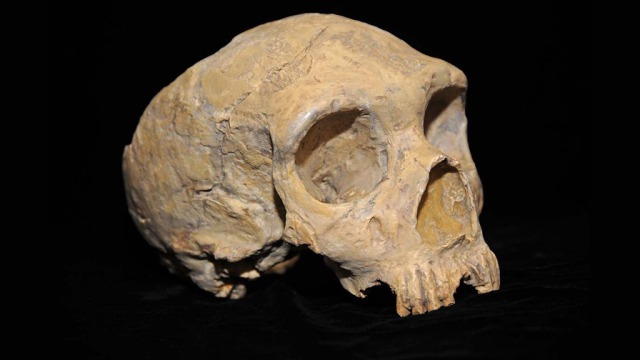Before we became the only remaining humans on the planet, Homo sapiens mated with Neanderthals and the closely related Denisovans. New research is now revealing that the common ancestor of Neanderthals and Denisovans interbred with its own predecessor, a population of “superarchaic” hominids.
This new model suggests a rewritten history of human evolution, and, if it holds, demonstrates that early human species interbred a lot more than scientists initially thought.
“I’m just excited about being able to see this far back in the past,” Alan Rogers, the study’s first author, told Gizmodo. “When I first started working on this stuff… I thought I’d be working on the origin of modern humans. It was a surprise to me that the interesting part of the story is what happened in the middle Pleistocene.”
Previous research has suggested that around 750,000 years ago, humans separated from an ancestor of both the Neanderthals and the Denisovans that populated Eurasia. But there is also evidence that another archaic ancestor already inhabited Eurasia. Perhaps the “Neandersovans” bred with these superarchaic hominins as well.
[referenced url=” thumb=” title=” excerpt=”]
The researchers developed a model based on a sample of modern European genome from the Simons Genome Diversity Project, as well as available Neanderthal genomes. They assumed that ancient European humans did not breed with Denisovans, because there isn’t much evidence to support that. They followed how mutations in either group would be carried forward or jump across species. According to their statistical analysis, the model that best fit the data was one where Neanderthals interbred with humans, Denisovans mixed with the superarchaic ancestor, and now, the novel hypothesis, that genetic information flowed between the superarchaic population and the Neandersovan ancestor population as well, according to the paper published in Science Advances. That superarchaic population might have been a descendant of Homo erectus, a descendant of Homo antecessor, or another hominin altogether.
The model comes with several other implications—not only would it push back the date that Neanderthals and Denisovans split, but it also predicts that humanity’s ancestors expanded out of Africa only three times: an early ancestor 1.9 million years ago, “Neandersovans” 700,000 years ago, and modern humans 50,000 years ago.
This new research came out of a 2017 work led by Rogers that argued the Neanderthals and Denisovans separated a long time ago, following bottleneck in their population. One pair of researchers, Fabrizio Mafessoni at the Max Planck Institute for Evolutionary Genetics and Kay Prüfer from the Max Planck Institute for the Science of Human History, replied that the model was missing data that caused it to produce unrealistic results—but Rogers then noted that including the data also led to unrealistic results. Rogers’ team took the critique to heart to produce a new model, which led to this paper and the novel hypothesis.
Mafessoni, who was not involved in producing the new study, told Gizmodo that while he hoped to review the new paper in a bit more depth and recreate its results, he thought “they’re doing a great job at developing something that’s a bit different,” and that the Neandersovan/superarchaic hominin mixing made sense. However, he also pointed out that the analysis doesn’t necessarily exclude other, more complex models explaining the interactions between the groups.
Should the model hold true, then the paper comes with two important implications: The first, which we already knew, is that modern humans maintain DNA from our super-ancient relatives. But more surprising is that our hominin ancestors interbred far more than you might have thought.
Rogers’ team is now planning to look at genetic data from indigenous inhabitants of Oceania, since these populations have Denisovan DNA. This will allow them to gain more insight into the relationships between early hominins.
Obviously, this kind of model-dependent work requires teasing apart clues from degraded DNA, as well as mutations that human populations have carried in our DNA throughout history. But it’s fascinating to think that we carry within in us the stories of long-extinct human species that influenced who we are today.
